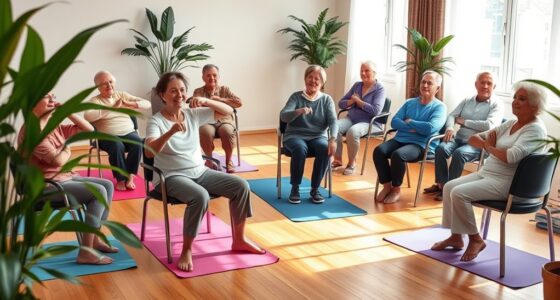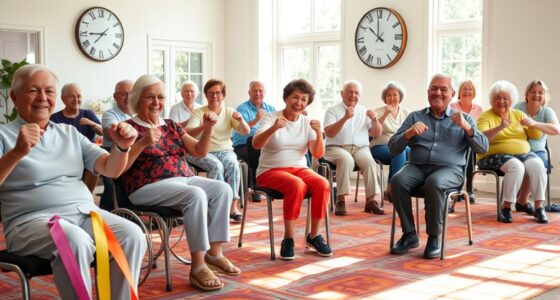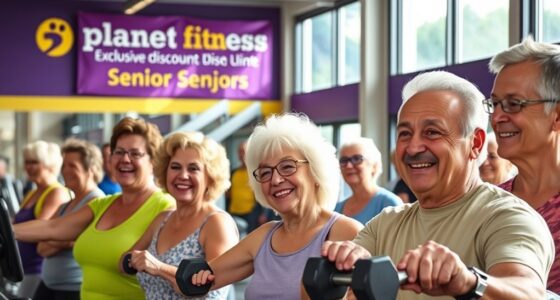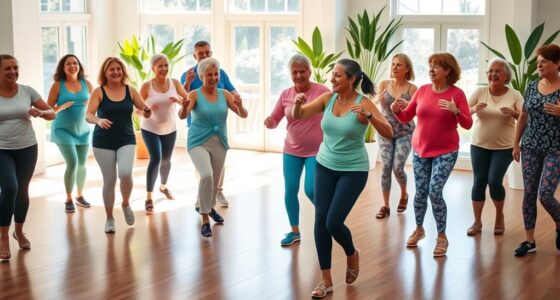Regular exercise can greatly enhance your life as a senior. Simple options like walking, chair exercises, or yoga can boost your mood, improve flexibility, and strengthen your muscles. Cycling provides low-impact cardio, while water-based exercises help your joints. Tai Chi combines movement with mindfulness, and Pilates focuses on core strength. Incorporating stretching routines keeps you flexible and reduces stress. Discover more about these exercises and how they can benefit you in various ways.
Key Takeaways
- Walking regularly boosts cardiovascular health and enhances mental well-being while promoting social interaction through group walks.
- Chair exercises improve mobility, balance, and strength, allowing seniors to maintain independence and reduce fall risk.
- Yoga enhances flexibility and balance, reduces chronic pain, and promotes mental clarity, making it ideal for seniors.
- Water-based exercises provide joint-friendly workouts, improving mobility and cardiovascular health while being suitable for various fitness levels.
- Incorporating stretching routines improves flexibility, posture, and emotional well-being, making daily activities easier and enhancing overall health.
Benefits of Regular Exercise for Seniors

Regular exercise offers numerous benefits for seniors, not just for physical health but also for mental well-being and social engagement.
Engaging in regular physical activity can boost your cardiovascular health, lowering the risk of heart disease and stroke. Strength training helps you maintain muscle mass, reducing the likelihood of sarcopenia. Plus, exercise enhances bone density, preventing osteoporosis and fractures. Additionally, consistent exercise routines can help improve flexibility and prevent injuries, promoting overall physical well-being. Research shows that antioxidant-rich foods can further support cognitive function and overall health. Furthermore, creating a supportive community around fitness can motivate seniors to stay active and engaged. It is important to note that early detection of health issues through regular check-ups can significantly impact seniors’ quality of life. Moreover, engaging in activities that celebrate home and heritage can enhance the enjoyment of exercise and promote a sense of belonging.
Mentally, working out triggers endorphin production, elevating your mood and reducing stress. You’ll also sleep better and feel more confident.
Exercise improves your mobility and balance, supporting independent living by making daily tasks easier. Finally, it fosters social connections, reducing feelings of loneliness through group activities.
Embrace exercise for a healthier, happier life!
Walking: A Gentle Yet Effective Option
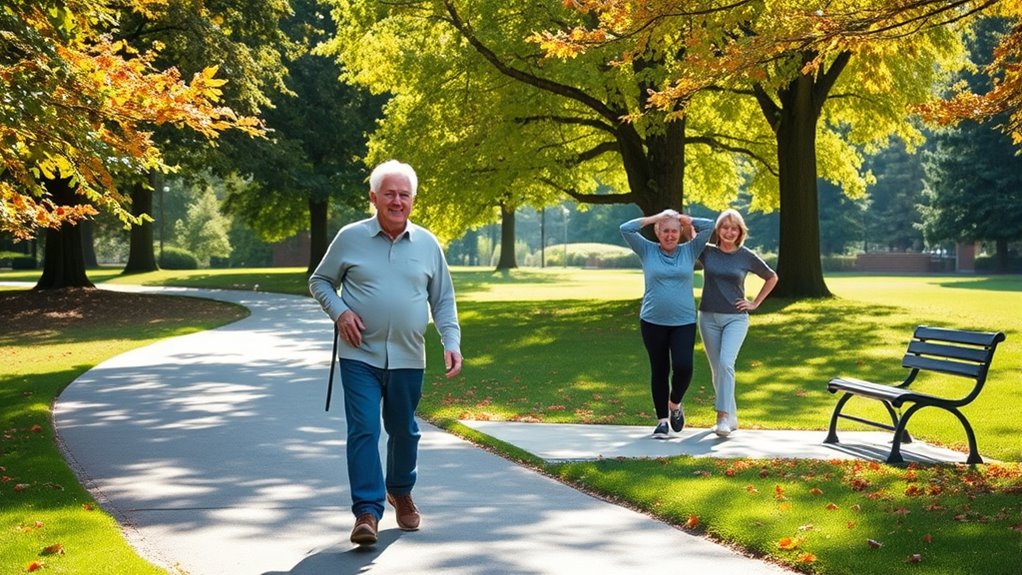
Walking is one of the simplest and most effective forms of exercise for seniors. It requires no special equipment and can be done almost anywhere.
Regular walking improves cardiovascular health, reducing your risk of heart disease and stroke. It strengthens your bones and muscles, while also enhancing mental well-being by alleviating anxiety and depression. Additionally, regular physical activity supports cognitive health, potentially slowing decline and lowering dementia risk. Engaging in walking can also transform your living environment into a more accessible space, making it easier for seniors to navigate their homes comfortably. Importantly, establishing clear rules for physical activity can help in creating a structured routine that encourages consistency. Aim for short walks of about 10 minutes, gradually increasing to 30 minutes daily. Moreover, incorporating networking opportunities with local community groups can provide motivation and companionship for seniors during their walks. Participating in group walks can foster social interaction, which is fundamental for emotional well-being. Regular walking can also improve air quality in your environment, as HEPA filtration systems help remove allergens that may impact respiratory health.
This gentle exercise not only boosts your energy levels but also promotes social interaction, which is crucial for emotional health.
Always consult your healthcare provider before starting a new walking routine to verify it’s safe for you.
Chair Exercises for Improved Mobility
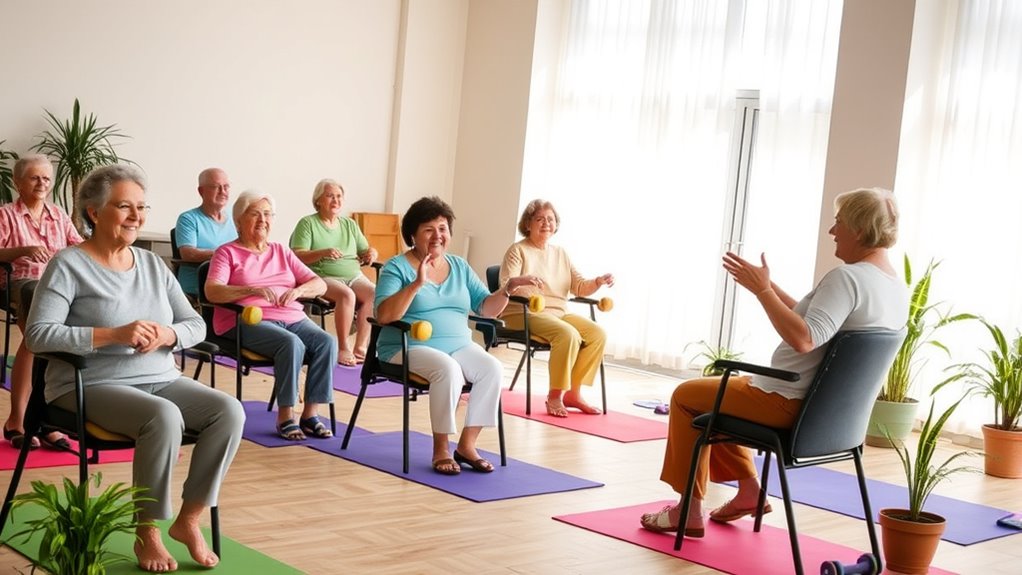
Chair exercises can be a fantastic way to enhance mobility, especially for seniors who may have difficulty with more strenuous activities. These exercises improve balance, reducing the risk of falls, and strengthen vital muscle groups like your core and legs. Chair exercises promote movement for sedentary individuals, encouraging more active lifestyles and greater independence. Incorporating various sleep training methods can also help seniors improve their overall well-being by ensuring they get adequate rest. Additionally, creating cozy spaces at home can make exercising more enjoyable and accessible for seniors. Regular physical activity, including daily exercise requirements, is essential for maintaining health and preventing obesity-related issues. Quality sleep enhances cognitive function, which is crucial for seniors as they engage in physical activities. Furthermore, maintaining an organized environment can significantly reduce stress levels, making it easier for seniors to engage in physical activities.
By practicing movements such as chair rises and seated arm raises, you can boost your upper and lower body strength while improving posture. Chair exercises also increase flexibility, providing relief from arthritis-related discomfort. Plus, they’re cost-effective and require no special equipment—just a sturdy chair at home.
To get started, warm up with gentle shoulder rolls and gradually incorporate various exercises. Consistency is key, so aim to practice regularly for the best results.
The Advantages of Yoga for Seniors
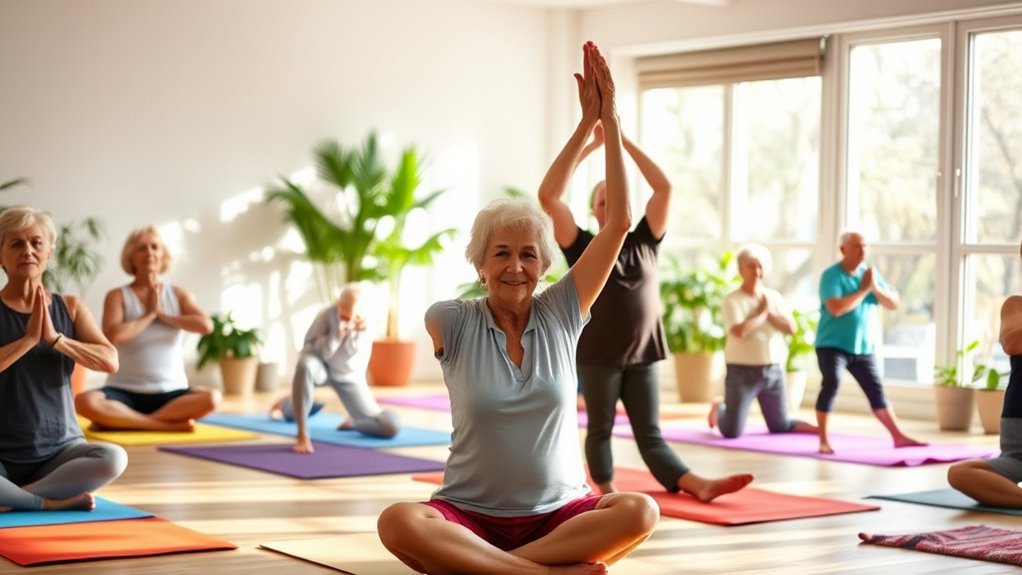
Yoga offers numerous benefits for seniors, including improved balance and flexibility, which greatly reduce the risk of falls. By practicing gentle stretches, you not only increase joint mobility but also strengthen bones and muscles, enhancing your overall stability. Furthermore, yoga supports bone mass maintenance, which is essential for preventing osteoporosis as you age. Regular practice can also lead to enhanced mental clarity, allowing seniors to stay focused and engaged in their daily activities. Additionally, incorporating required minimum distributions into your financial planning can help ensure you have the resources needed to maintain your health and wellness as you age. Moreover, engaging in yoga can foster a growth mindset, empowering seniors to embrace new challenges and opportunities for personal development. Studies indicate that digital literacy programs can further enhance seniors’ confidence and engagement in activities like yoga.
Moreover, research has shown that yoga can reduce chronic pain, providing a holistic approach to managing discomfort. Additionally, yoga helps manage chronic pain and promotes relaxation, reducing stress and improving sleep quality. The social aspect of group classes can also boost your mood and mental clarity.
Ultimately, yoga can contribute to a better quality of life, ensuring you remain active and engaged in your daily activities for years to come.
Cycling: A Low-Impact Cardio Workout
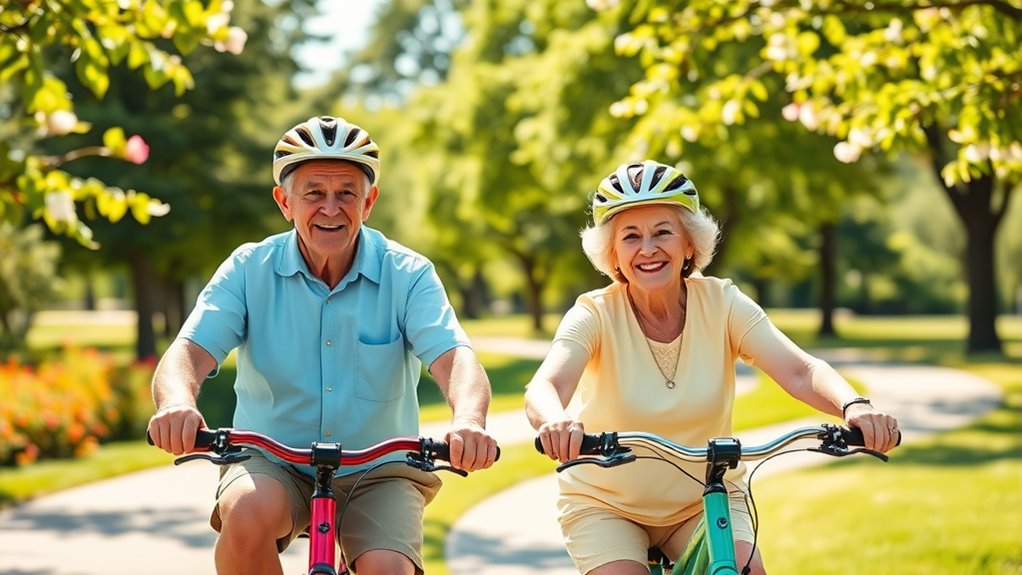
Cycling can be an excellent way for seniors to enjoy a low-impact cardio workout that benefits both body and mind. This activity minimizes stress on your joints, making it ideal if you have knee or hip issues. Regular cycling improves your heart health, lowers blood pressure, and helps manage weight, which is essential as you age. It also strengthens leg muscles and enhances your balance, reducing the risk of falls. Additionally, cycling helps to combat weight gain common in seniors, promoting a more active lifestyle. Furthermore, incorporating freshly squeezed juices into your diet can provide essential nutrients that support overall health. Furthermore, engaging in regular physical activity like cycling can enhance cardiovascular health, which is crucial for maintaining overall well-being as you age. Studies show that cycling regularly can significantly improve muscle endurance and flexibility, which are key factors for staying active. Mentally, cycling boosts cognitive function and releases endorphins, improving your mood. Plus, it offers opportunities for social engagement through group rides. Combining cycling with educational toys can provide fun and interactive ways to stimulate mental engagement. Moreover, cycling in public spaces can enhance artistic interaction and provide a sense of community. Whether you choose a traditional bike or a tricycle, cycling can elevate your overall quality of life and promote independence.
Rowing Machines for Full-Body Strength

For seniors looking to enhance their fitness routine, rowing machines offer a fantastic option for full-body strength training.
These low-impact machines minimize stress on your joints while engaging your legs, core, back, and arms. By using a rowing machine, you’ll not only build muscle strength but also improve cardiovascular health, which is essential for reducing heart disease risk. Additionally, comfort and ergonomic design are crucial for ensuring a positive experience during workouts, especially for those with limited flexibility. Research indicates that early exposure to STEM can enhance cognitive function, making rowing an excellent choice for seniors focused on mental engagement. Moreover, engaging in regular physical activity can help counteract the effects of emotional dysregulation, providing a stable outlet for stress relief. Furthermore, incorporating camping tips into your routine can enhance overall well-being by promoting outdoor activities and social interactions. Engaging in low-impact exercises like rowing can also lead to improved joint health, making it easier for seniors to maintain an active lifestyle. Additionally, a balanced diet rich in protein sources can further support muscle recovery and overall health.
Plus, the rhythmic motion helps release endorphins, boosting your mood and reducing stress. With adjustable resistance, you can tailor workouts to your fitness level, making it suitable for everyone.
Regular use can enhance your mobility, aid in weight management, and even support cognitive function, ensuring you stay active and engaged in daily life.
Water-Based Exercises for Joint Health
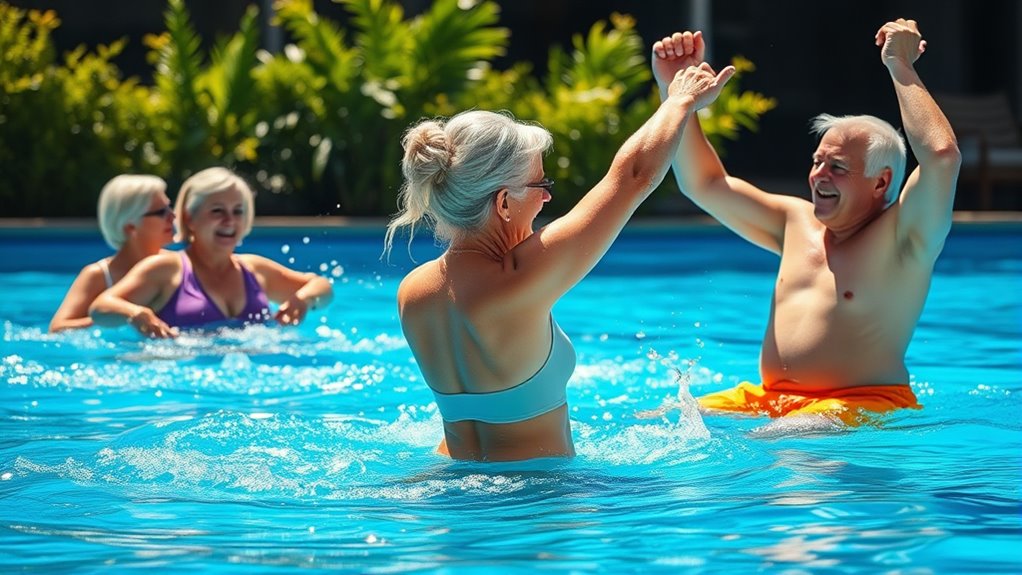
Water-based exercises provide an excellent way to maintain joint health, especially for seniors. These low-impact activities improve joint mobility and reduce pain, perfect for those dealing with arthritis. The buoyancy of water supports your body, easing pressure on your joints and allowing for greater flexibility. You can enhance muscle strength without excessive strain, while also boosting cardiovascular health through improved blood circulation. Additionally, these exercises aid in managing osteoporosis by improving bone density, which is crucial for seniors. Studies show that engaging in water aerobics can lead to significant improvements in overall fitness levels. For example, many participants in aquatic exercise programs report increased vitality and energy. Interestingly, regular participation in these exercises can help diversify crypto assets within a broader investment strategy to safeguard financial health. Try water aerobics, water walking, or aqua jogging to keep active without risking injury. Incorporate simple leg lifts or adaptable jumping jacks for further benefits.
To maximize safety and comfort, opt for warmer water temperatures and consider using water shoes. Regular aquatic exercise can greatly enhance your overall physical well-being and quality of life.
Tai Chi: Mindfulness and Movement

Engaging in exercises that promote joint health can lead you to explore other gentle activities that enhance both physical and mental well-being.
Tai Chi, a traditional Chinese martial art, combines slow movements with mindfulness, making it an excellent low-impact option for seniors. You’ll improve your balance and coordination, greatly reducing the risk of falls. This practice isn’t only great for your cardiovascular health but also boosts muscle strength and cognitive function. Plus, it encourages mindfulness, helps reduce symptoms of depression, and promotes social interaction. Furthermore, Tai Chi also reduces anxiety and tension, enhancing emotional stability in participants.
With no special equipment needed, Tai Chi is accessible and can be practiced indoors or outdoors. Consider joining a class or following online videos to start reaping the benefits today!
The Role of Pilates in Core Strength

While many forms of exercise focus on different muscle groups, Pilates stands out for its emphasis on core strength—an essential foundation for stability and balance, especially as we age.
By targeting your abdomen and lower back, Pilates helps improve posture and reduces the risk of falls, a considerable concern for older adults. This low-impact exercise is gentle on your joints while enhancing flexibility and mobility, making everyday activities easier. Regular practice may also lower the risk of chronic diseases as it supports overall health.
Key exercises like the Roll-Up and Plank engage your core effectively. Plus, Pilates promotes mental well-being through mindful breathing and relaxation.
You can adapt the practice to suit your needs, whether on a mat or using equipment. Regular sessions can considerably contribute to your overall health and quality of life.
Incorporating Stretching Into Daily Routines
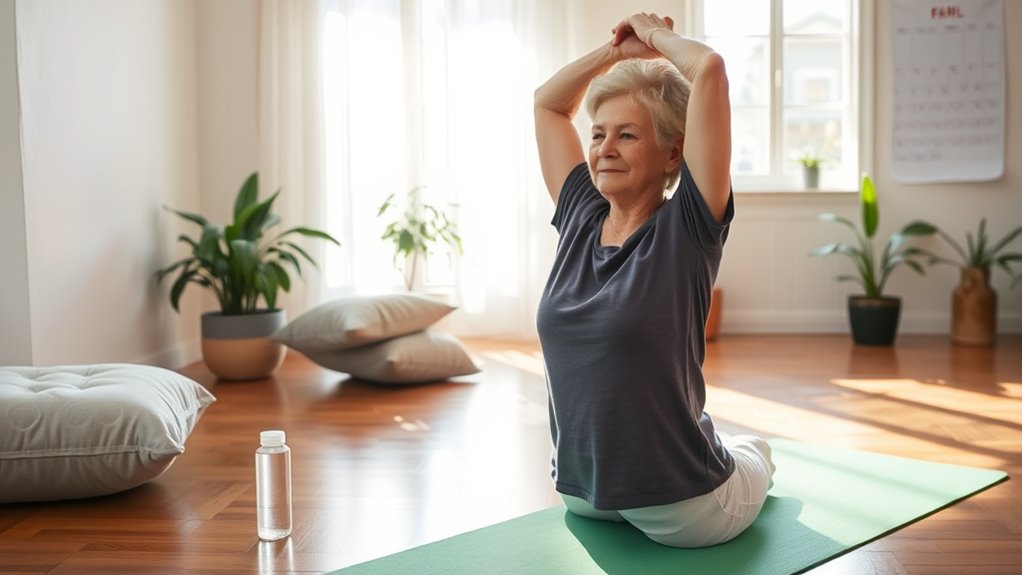
Incorporating stretching into your daily routine complements the benefits gained from Pilates and other exercises focused on core strength.
Daily stretching greatly improves flexibility and balance, making everyday tasks easier. You can start your day with morning stretches to prepare your muscles or wind down with evening stretches to relax. Incorporating regular stretching helps maintain balance and coordination for daily tasks.
Daily stretching enhances flexibility and balance, simplifying daily tasks and promoting relaxation through morning and evening routines.
Whether seated or standing, these exercises accommodate various mobility levels. Aim to stretch at least two to three times a week, holding each stretch for 15 to 60 seconds.
Gentle stretches can even be done from bed if mobility is an issue. Regularly incorporating stretching not only enhances your physical health but also supports emotional well-being by alleviating stress and improving posture.
Frequently Asked Questions
What Should Seniors Wear for Comfortable Exercise Sessions?
When you’re gearing up for comfortable exercise sessions, focus on breathable, moisture-wicking tops made from synthetic fabrics.
Choose pants or leggings that allow for flexibility without being too long to avoid trips.
Opt for supportive footwear with good arch support and slip-resistant soles to enhance safety.
Don’t forget about supportive sports bras that are easy to put on.
Prioritizing comfort and ease will make your workouts much more enjoyable and effective.
How Can Seniors Stay Motivated to Exercise Regularly?
Staying motivated to exercise regularly can be challenging, but you can make it enjoyable. Set realistic goals and celebrate your achievements to boost your confidence.
Find a workout buddy or join a class to add social interaction, which can keep you engaged. Mix up your routine with varied activities you love, like dancing or swimming.
Track your progress, and remember to be flexible, adjusting your plans based on how you feel each day.
Are There Any Exercises to Avoid for Seniors?
When considering exercises to avoid, you should steer clear of high-risk activities like leg presses, crunches, and behind-the-neck pull-downs.
These can lead to injuries, especially if you’re not using proper form. Plyometric exercises and weighted squats may add unnecessary stress to your joints.
Instead, focus on safer alternatives, like walking or chair yoga, which can provide benefits without the added risk of injury.
Always consult a healthcare provider before starting any new routine.
How Often Should Seniors Exercise Each Week?
Think of exercise as a key that opens up a healthier, happier you!
Seniors should aim for at least 150 minutes of moderate-intensity aerobic activity or 75 minutes of vigorous activity each week. You can break this down into manageable 10- to 15-minute sessions throughout the day.
Don’t forget to include muscle-strengthening exercises twice a week and balance activities to keep you steady on your feet.
Consistency is key for reaping the benefits!
What Are the Signs of Overexertion During Exercise?
When you exercise, it’s vital to recognize signs of overexertion.
If you experience excessive fatigue, persistent soreness, or a noticeable decrease in your performance, you might be pushing too hard. Dizziness or lightheadedness are also red flags.
Pay attention to your body; if you feel muscle weakness or confusion, it’s time to take a break. Always listen to your limits to prevent injuries and guarantee a safe workout experience.
Conclusion
Incorporating simple exercises into your daily routine can be like adding vibrant colors to a canvas, transforming your life into a masterpiece of health and energy. Whether it’s a gentle walk in the park or a calming session of yoga, every movement counts. Embrace these activities, and you’ll not only strengthen your body but also uplift your spirit. So, lace up those shoes or roll out your mat—your journey to a more active and fulfilling life starts today!


